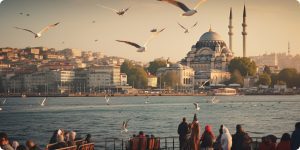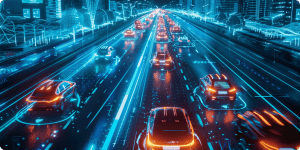And how to get through it
Content
- Overview of Traffic in London
- Major Traffic Hotspots
- Causes of Traffic Congestion
- Public Transport Options
- Congestion Charge and ULEZ
- Best Times to Travel
- Tips for Avoiding Traffic
- Future Developments and Improvements
- Conclusion
London, one of the most vibrant and bustling cities in the world, is notorious for its traffic congestion. Navigating through the streets of this historic city can be a daunting task for both residents and visitors. In this comprehensive guide, we’ll cover everything you need to know about traffic in London, from the current state of congestion to tips on how to avoid traffic jams. This article is designed to be your ultimate resource for understanding and dealing with London’s traffic efficiently.
1. Overview of Traffic in London
London’s traffic is a complex system influenced by numerous factors, including population density, road layout, public transport availability, and ongoing construction projects. According to recent studies, London is ranked among the most congested cities in the world. The average driver spends around 227 hours per year in traffic, which highlights the extent of the issue. The high volume of vehicles on the road, combined with London’s historic street layout, creates significant challenges for traffic management.
One of the key factors contributing to London’s traffic congestion is its population density. With over 9 million residents, London is one of the most densely populated cities in Europe. This high population density leads to increased demand for road space, resulting in frequent traffic jams and slow-moving traffic. Additionally, the influx of tourists and business travelers further exacerbates the congestion problem, particularly in central London and popular tourist areas.
Moreover, London’s road layout plays a crucial role in the city’s traffic woes. Many of the streets were designed centuries ago and are not equipped to handle modern traffic volumes. Narrow roads, one-way systems, and a lack of adequate parking facilities contribute to the overall congestion. Despite ongoing efforts to modernize and expand the road network, the historic layout of the city presents inherent limitations that are difficult to overcome.
2. Major Traffic Hotspots
Several areas in London are notorious for heavy traffic. Some of the major hotspots include:
- Central London: Areas like Oxford Street, Piccadilly Circus, and Trafalgar Square are constantly bustling with vehicles and pedestrians. The concentration of commercial activities, shopping centers, and tourist attractions makes central London a traffic nightmare. The narrow streets, combined with the high volume of buses, taxis, and delivery vehicles, result in significant congestion, especially during peak hours.
- West End: Known for its theaters and shopping districts, the West End experiences significant traffic, especially in the evenings. The West End is home to numerous entertainment venues, restaurants, and shops, attracting both locals and tourists. As a result, the roads in this area are often congested, with long queues of vehicles trying to navigate through the busy streets. The lack of sufficient parking spaces further exacerbates the problem, as drivers circle the area looking for a place to park.
- Financial District: The City of London and Canary Wharf are busy during rush hours as commuters travel to and from work. The financial district is the heart of London’s business activities, with thousands of people commuting to the area daily. The high concentration of offices, banks, and corporate headquarters creates a significant demand for road space, leading to severe congestion during peak commuting times. The limited availability of parking spaces and the presence of numerous construction projects add to the traffic woes in this area.
For a detailed map of traffic hotspots, visit Transport for London.
3. Causes of Traffic Congestion
The primary causes of traffic congestion in London include:
- High Population Density: London has a population of over 9 million people, leading to high vehicle usage. The sheer number of residents, coupled with the influx of tourists and business travelers, creates a significant demand for road space. The limited capacity of the road network is unable to accommodate the high volume of vehicles, resulting in frequent traffic jams and delays.
- Narrow Streets: Many of London’s streets were designed centuries ago and are not equipped to handle modern traffic volumes. The historic layout of the city, with its narrow and winding streets, poses significant challenges for traffic management. The lack of adequate space for multiple lanes, combined with the presence of pedestrian zones and restricted access areas, further contributes to the congestion problem.
- Construction Projects: Continuous development and maintenance work often lead to road closures and diversions. London is a city that is constantly evolving, with numerous construction projects aimed at improving infrastructure and expanding the road network. However, these projects often result in temporary road closures and diversions, causing significant disruptions to traffic flow. The presence of construction equipment and materials on the roads further reduces the available space for vehicles, leading to increased congestion.
- Public Events: Events like parades, protests, and football matches can cause significant disruptions. London is a hub for various public events, including parades, protests, and sports events. These events attract large crowds and often result in road closures and diversions to ensure public safety. The increased foot traffic, combined with the presence of event-related vehicles, adds to the overall congestion in the city.
For more information on current construction projects and their impact, check London Roadworks.
Check out the related article: Ready, Set, Fly: Simple Steps to Prepare for a Long Flight
4. Public Transport Options
London boasts an extensive public transport network that can help alleviate traffic congestion. Key options include:
- London Underground: Also known as the Tube, it is the fastest way to navigate the city. The London Underground consists of 11 lines that cover the entire city, providing a reliable and efficient means of transport. The frequent services and extensive network make the Tube a popular choice for commuters and tourists alike. However, during peak hours, the Tube can become overcrowded, and delays are not uncommon. Plan your journey on the Tube.
- Buses: London’s bus network covers the entire city, offering a reliable alternative to driving. The iconic red buses operate on numerous routes, connecting various parts of the city. Buses are equipped with modern amenities, including free Wi-Fi and accessibility features. However, bus travel can be affected by road traffic, especially during peak hours. London bus routes and schedules.
- Trams and Light Rail: Areas like South London are served by trams, while the Docklands Light Railway (DLR) connects East London. The tram and light rail services provide additional transport options, particularly in areas not covered by the Tube. These services are generally reliable and offer a comfortable travel experience. Learn more about the DLR.
- Cycling: London has invested in cycling infrastructure, including bike lanes and rental schemes like Santander Cycles. Cycling is a growing mode of transport in London, with dedicated cycle lanes and routes across the city. The Santander Cycles rental scheme offers an affordable and convenient option for short journeys. However, cyclists must navigate the busy streets and contend with traffic, which can be challenging. Santander Cycles information.
5. Congestion Charge and ULEZ
To combat traffic and pollution, London has implemented several measures:
- Congestion Charge: A fee charged to vehicles entering Central London during peak hours, aimed at reducing traffic. The Congestion Charge zone covers the central area of London and operates from Monday to Friday. Drivers must pay a daily fee to enter the zone, with exemptions for certain vehicles, such as electric cars and motorcycles. The revenue generated from the Congestion Charge is reinvested in public transport and infrastructure improvements. Details on the Congestion Charge.
- Ultra Low Emission Zone (ULEZ): A zone where vehicles must meet strict emission standards or pay a daily charge. This encourages the use of cleaner vehicles. The ULEZ operates 24 hours a day, seven days a week, and covers the same area as the Congestion Charge zone. Vehicles that do not meet the required emission standards must pay a daily charge to enter the zone. The ULEZ aims to reduce air pollution and improve public health by encouraging the use of low-emission vehicles. ULEZ information.
6. Best Times to Travel
Understanding the best times to travel can help you avoid the worst traffic:
- Early Morning: Traveling before 7 AM can help you avoid the morning rush hour. Early morning travel is generally less congested, with fewer vehicles on the road. This is an ideal time for commuters who need to reach their destination early and want to avoid the heavy traffic associated with rush hour.
- Midday: Between 10 AM and 3 PM, traffic is generally lighter. Midday travel offers a window of opportunity to avoid the peak morning and evening rush hours. The roads are less congested, making it a convenient time for running errands or traveling to appointments. However, certain areas may still experience traffic due to ongoing construction projects or public events.
- Evening: After 7 PM, traffic starts to ease off, making it a better time for travel. Evening travel is less congested as the majority of commuters have already reached their destinations. This is a good time for those who prefer a more relaxed journey without the stress of navigating through heavy traffic. However, it is important to note that certain areas, such as entertainment districts, may still experience traffic due to the influx of visitors.
For real-time traffic updates, check Google Maps
7. Tips for Avoiding Traffic
Here are some practical tips to help you navigate London’s traffic more efficiently:
- Use Navigation Apps: Apps like Google Maps and Waze provide real-time traffic updates and suggest alternative routes. These apps use data from other drivers to give you the best route, avoiding traffic jams and road closures. They also provide estimated travel times and can alert you to any incidents on your route. Regularly updating these apps and checking them before and during your journey can save you significant time. Download Google Maps or Waze.
- Plan Ahead: Check for road closures and public transport disruptions before you travel. Websites like Transport for London provide real-time updates on roadworks, accidents, and public transport delays. Planning your route ahead of time allows you to anticipate and avoid potential delays.
- Consider Public Transport: Use the Tube or buses for faster and more reliable travel. Public transport in London is generally efficient and can help you avoid the stress of driving in heavy traffic. The Tube, in particular, can be much faster than driving, especially during peak hours. Plan your journey.
- Avoid Driving in Central London: If possible, avoid driving in heavily congested areas and consider parking outside the city center. Park-and-ride facilities, where you park your car on the outskirts and take public transport into the city, can be a good alternative. This approach can save you from the congestion and high parking fees in central London. Parking information.
- Carpooling: Sharing your ride with others can reduce the number of vehicles on the road. Apps like BlaBlaCarfacilitate carpooling, making it easier to find and share rides with people going in the same direction. Carpooling can also make your journey more pleasant and environmentally friendly.
- Flexible Working Hours: If your job allows, consider starting your workday earlier or later to avoid peak traffic times. Flexible working hours can significantly reduce the amount of time you spend in traffic, making your commute faster and less stressful.
- Cycling or Walking: For shorter journeys, consider cycling or walking. London has invested heavily in cycling infrastructure, making it a viable and often quicker option for many routes. Walking can also be faster than driving for short distances, and it’s a great way to get some exercise while avoiding traffic. Santander Cycles information.
8. Future Developments and Improvements
London is continuously working on improving its traffic situation. Some future developments include:
- Crossrail (Elizabeth Line): This new railway line aims to reduce congestion on existing lines and provide faster travel across London. The Elizabeth Line will connect major areas of London and the surrounding regions, offering a high-capacity and high-frequency service. It is expected to ease pressure on the existing Tube and rail services, providing commuters with a faster and more reliable alternative. The line is set to fully open in stages, significantly enhancing the overall transport network. Learn more about Crossrail.
- Cycle Superhighways: Expansion of dedicated cycle routes to encourage more people to cycle. The Cycle Superhighways are designed to provide safe and direct routes for cyclists, separated from other traffic. These routes aim to make cycling a more attractive and viable option for commuters, reducing the number of vehicles on the road. The expansion of these superhighways is a key part of London’s strategy to promote sustainable and healthy modes of transport. Cycle Superhighways information.
- Smart Traffic Management: Implementation of advanced traffic management systems to optimize traffic flow. These systems use real-time data and advanced algorithms to control traffic signals, manage road usage, and respond to incidents quickly. The goal is to reduce congestion, improve travel times, and enhance overall road safety. Smart traffic management involves integrating various technologies, including sensors, cameras, and communication systems, to create a more efficient and responsive traffic network. Smart traffic management initiatives.
- Low Emission Zones: Expansion of low emission zones to further reduce air pollution. Following the success of the Ultra Low Emission Zone (ULEZ), there are plans to expand low emission zones to cover more areas of London. These zones aim to encourage the use of cleaner vehicles and reduce the levels of harmful pollutants in the air. The expansion of low emission zones is part of London’s broader strategy to tackle air pollution and improve public health. ULEZ information.
- Electric Vehicle Infrastructure: Increasing the number of electric vehicle charging points to promote the use of electric cars. As part of efforts to reduce vehicle emissions, London is investing in the infrastructure needed to support electric vehicles. This includes increasing the availability of charging points across the city, making it easier and more convenient for drivers to switch to electric cars. The aim is to make electric vehicles a practical and attractive option for more people, contributing to cleaner air and reduced traffic congestion. Electric vehicle infrastructure plans.
Traffic in London can be challenging, but with the right knowledge and tools, it’s possible to navigate the city efficiently. By understanding the major hotspots, causes of congestion, and utilizing public transport options, you can minimize your time spent in traffic. Stay informed about future developments and use the provided tips to make your travel in London as smooth as possible.
Navigating through London’s traffic doesn’t have to be a nightmare. With proper planning and by leveraging available resources, you can enjoy the city’s rich offerings without the stress of being stuck in traffic. Remember to check for real-time updates, use navigation apps, and consider alternative modes of transport to make your journey more pleasant.
London is a city that is constantly evolving, with ongoing efforts to improve its transport network and reduce congestion. By staying informed and adapting to these changes, you can make the most of your time in this dynamic and vibrant city. Whether you are a resident or a visitor, understanding how to navigate London’s traffic can significantly enhance your experience and make your journeys more efficient and enjoyable.
For convenient transfers consider using Gettransfer.com













